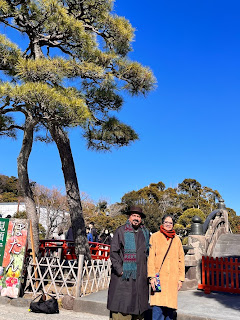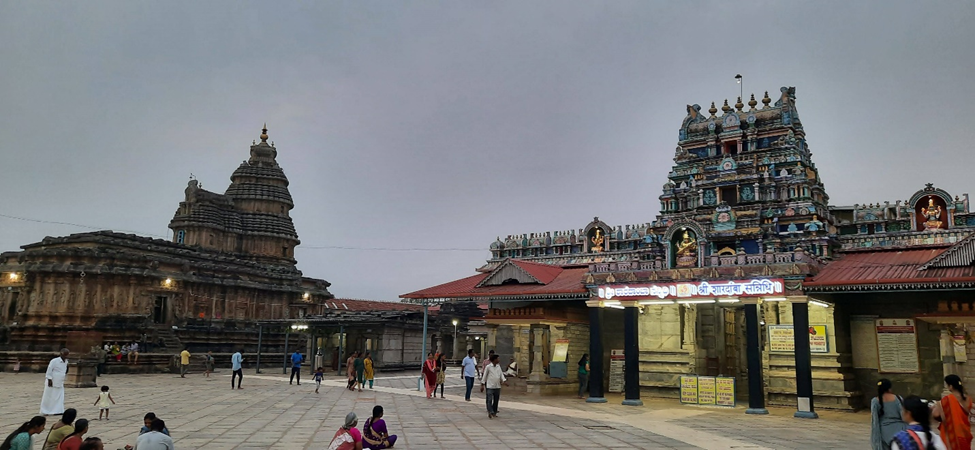KAMAKURA, JAPAN - full of temples and shrines - Sathya's travelogue
Sathya’s Travelogue on Kamakura trip
10th and 12th February 2024
KAMAKURA a beautiful town situated nor far from Tokyo, is full of shrines and temples.
(Like Kumbakonam in Tamil Nadu, INDIA)
We got down at Kita Kamakura on the 10th of February 2024, and the greenery is awesome. Weather god was on our side, as it was slightly drizzling but sunny.
We planned to visit at least eight Shrines on this day but could complete only four. I always believe in spending more time at each spot and enjoy its structure and beauty, rather than chasing numbers.
Incase if you are carrying luggage, better to get down at Kamakura station and safely keep them on the safety coin lockers available at the station. (Different sizes are available depending on the size to a maximum of 700 Yen.
You can buy one GOSHUIN stamp book in advance and collect the goshuin stamp at each shrine, as a memory.
Time to start the KAMAKURA tour….
------------------------------------------------------------------------------------------------------------------------
Engakuji Temple – Zen temple
Simply Amazing temple. very close to kita Kamakura station, walkable. Architectural beauty. One need to spend at least half day here to explore fully.
It is situated on a hillock and one need to climb few 100 steps to get into the temple. Also be prepared for a stroll of at least 3-4 kilometers inside the temple.
Don’t forget to grab a copy of the temple map at the entrance, (near the ticket counter) as it is very useful to explore the temple fully.
Engakuji is one of the leading Zen temples in eastern Japan and the number two of Kamakura's five great Zen temples. It was founded by the ruling regent Hojo Tokimune in the year 1282, one year after the second invasion attempt by the Mongols had been reverted. One purpose of the new temple was to pay respect to the fallen Japanese and Mongolian soldiers.
Engakuji is built into the slopes of Kita-Kamakura's forested hills. The first main structure encountered upon entering the temple grounds is the Sanmon main gate, which dates from 1783. Behind it stands the temple's main hall, the Butsuden, which displays a wooden statue of the Shaka Buddha. The Butsuden was rebuilt relatively recently in 1964 after the former building had been lost in an earthquake.
Further into the temple grounds, the Shariden is a beautifully designed hall in which a tooth of Buddha is enshrined. It is designated a national treasure, but can only be seen from a distance during most of the year. Another national treasure found at Engakuji is the temple's large bell (ogane). It stands on a hill next to a teahouse where visitors can enjoy a cup of tea, amazake (sweet sake) or Japanese sweets in a calm environment.
Engakuji is a popular spot for autumn colors, which usually reach their peak around early December. The temple entrance, which is surrounded by many maple trees, is a particularly popular photo object.
Tokeiji Temple
Just five minutes’ walk from Engaku ji temple. I was not impressed with this temple, and it houses hundreds of cemeteries. We could see many locals performing some kind of rituals at the cemetery.
Better to avoid this from the list.
Tokeiji (東慶寺, Tōkeiji) is a small branch temple of the Engakuji school within the Rinzai sect of Zen Buddhism. Its head temple, the Engakuji Temple, stands just a few hundred meters away on the opposite side of the railway tracks.
Tokeiji was founded by the wife of the regent Hojo Tokimune in 1285 after Tokimune had died at a young age. Until the end of the Edo Period (1603-1868), the temple served as a shelter for women who suffered abuse by their husbands and sought a divorce. An official divorce could be attained by staying at the temple for three years.
Jochi ji Temple – Zen
Fourth most important Zen temple
Another amazing temple, with nature at its best.. just loved this place…
Main Hall (Dongeden)
Jochiji is the number four of Kamakura's five great Zen temples. It is a branch temple of the Engakuji school of the Rinzai sect of Zen Buddhism. Its head temple, the Engakuji Temple, stands just a few hundred meters away on the opposite side of the railway tracks.
Jochiji was founded in 1283 by members of the ruling Hojo family on the occasion of the premature death of a son. Once a large temple complex with many buildings and subtemples, Jochiji is now small and calm. In its main hall, the temple's main object of worship, a Buddhist trinity of the Amida Buddha, Shaka Buddha and Miroku Buddha, is displayed.
Behind the temple's main hall, a circular path leads through the temple garden and past a graveyard and some caves. At the temple's entrance, one of the ten celebrated wells of Kamakura can be found, but it seems to have lost some of its beauty over the centuries. Next to Jochiji starts the Daibutsu hiking trail, which leads to the Great Buddha in about an hour.
Meigetsuin temple - shrine
Meigetsuin Temple also known as the Hydrangea Temple
Meigetsuin Temple is a temple of the Rinzai Zen Sect founded in 1160 in Kamakura. It is also known as Ajisaidera ("Hydrangea Temple") because hydrangeas bloom in abundance on the temple grounds during the rainy season around June. 95% of the hydrangeas here are of the Hime Ajisai ("Princess Hydrangea") variety, which are colored blue.
The temple was originally a repose built by a son in memory of his father who had died in the struggle for power between the Taira and Minamoto clans in the late Heian Period (794-1185). It later became part of a larger temple complex called Zenkoji, which was abolished during anti-Buddhist movements soon after the Meiji Restoration of 1868, leaving only Meigetsuin to remain as an individual temple today.
In the back of Meigetsuin's lush temple grounds stands the main hall (Hojo). The building features a nice circular window, which frames the scenery of the inner garden behind it. The inner garden is known for its irises and is open to visitors only during two periods of about two weeks per year: in June when the irises are in bloom, and in late November/early December when the autumn colors are at their best. An additional admission fee applies.
Also of interest is the founder's hall (Soyudo), a thatched roof building that enshrines the temple's founder and stores mortuary tablets of the succeeding head priests. Next to the hall is a cave (yagura) that was dug into the side of the hill many centuries ago. The cave served as a tomb and is among the largest of multiple such caves found in the hills around Kamakura.
Due to the temple's connection to the moon (Meigetsu literally means "bright moon"; and phonetically can also mean "harvest moon"), rabbits are associated with it in relation to the Japanese folklore of a rabbit pounding a rice cake on the moon. Accordingly, rabbit designs are found on some of the temple's decorations, while a few real rabbits are kept in cages.
Daihatsu
Great Buddha of Kamakura - Large bronze Buddha Statue
In fact, we did not visit during this tour, but we visited some time back. I thought of including it in this travelogue, as this is a MUST SEE place. (It is more of an archaeological wonder, than a temple, in my opinion)
The Great Buddha of Kamakura (鎌倉大仏, Kamakura Daibutsu) is a bronze statue of Amida Buddha, which stands on the grounds of Kotokuin Temple. With a height of 11.4 meters, it has long been the second tallest bronze Buddha statue in Japan, surpassed only by the statue in Nara's Todaiji Temple and some recent creations.
The statue was cast in 1252 and originally located inside a large temple hall. However, the temple buildings were destroyed multiple times by typhoons and a tsunami in the 14th and 15th centuries. So, since the late 15th century, the Buddha has been standing in the open air.
Tsurugaoka Hachimangu
Kamakura’s most important Shinto shrine
I would rate this as the most amazing shrine in Kamakura..
Tsurugaoka Hachimangu is Kamakura's most important shrine. It was founded by Minamoto Yoriyoshi in 1063, and enlarged and moved to its current site in 1180 by Minamoto Yoritomo, the founder and first shogun of the Kamakura government.
The shrine is dedicated to Hachiman, the patron god of the Minamoto family and of the samurai in general. The deified spirits of the ancient Emperor Ojin who has been identified with Hachiman, Hime-gami and Empress Jingu are enshrined at Tsurugaoka Hachimangu Shrine.
The shrine is reached via a long, wide approach that leads from Kamakura's waterfront through the entire city center, with multiple torii gates along the way. The main hall (Hongu or Jogu) stands on a terrace at the top of a wide stairway. The main hall includes a small museum, which displays various treasures owned by the shrine, such as swords, masks and documents.
To the left of the stairway stood until 2010 a large ginkgo tree, which predated the shrine, and was once used as a hideout in an ambush attack on a shogun. Every autumn, the tree turned beautifully golden, but it did not survive a winter storm in March 2010. At the base of the stairway stands the Maiden, a stage for dance and music performances. Other structures on the shrine grounds include the Wakamiya Shrine, a secondary shrine to the right of the stairway and various auxiliary buildings.
Hope you enjoyed it.. thanks for reading.
vsathyamurthy@gmail.com
















Comments
Post a Comment